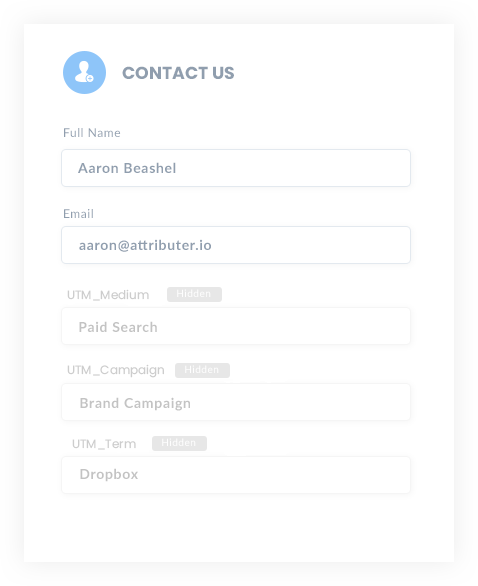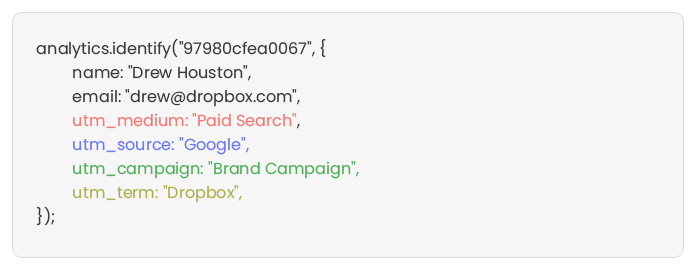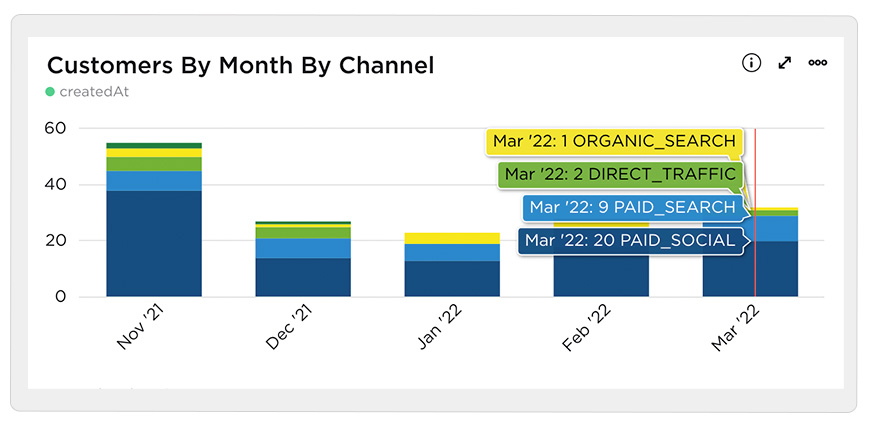Do you know what marketing campaigns and channels are generating the majority of your leads, opportunities & customers?
In this article, we’ll show you how to capture UTM parameters and other marketing attribution data and send it into CRM, so you can run reports that show you exactly what channels and campaigns are generating customers & revenue.
Key takeaways:
- Connecting campaign data from UTM tags with CRM data allows you to achieve accuracy in your ROAS and sales reports.
- There are four methods for capturing UTMs for your CRM tool. A dedicated UTM capture tool, hidden fields in form builders, Google Tag Manager, and customer data platforms.
- Examples of what you can accurately report on when tracking UTM parameters in your CRM include leads by channels, customers by channels, or revenue by campaign.
Why It’s Important to Track UTM Parameters in Your CRM
It’s easy to track what channels and campaigns are driving website visitors using campaign reports in Google Analytics and other analytics tools. But if you’re a business that sells your product offline, and you generate leads from your website that you follow up with to make the sale, tracking website visitors isn’t enough. In fact, it may even be causing you to make the wrong decisions about where to invest.
Imagine the table below shows the results from your Facebook & Google Ad campaigns:
| Facebook Ads | Google Ads | |
| Spend | $2,000 | $2,000 |
| Visitors | 200 | 100 |
| Goals (Lead form completions) | 20 | 10 |
If you were just using Google Analytics and this was the only information you had access to—visitors and leads—it would look like Facebook Ads are far outperforming Google Ads. You got 2x more leads for the same budget.
However, imagine if you were tracking these campaigns in a CRM such as HubSpot or Salesforce, and could see the results all the way through to the number of customers and amount of revenue generated.
You’d have something like this:
| Facebook Ads | Google Ads | |
| Spend | $2,000 | $2,000 |
| Visitors | 200 | 100 |
| Leads | 20 | 10 |
| Customers | 2 | 5 |
| Revenue | $8,000 | $25,000 |
When you’re able to track campaign effectiveness all the way through to customers and revenue, you can see the real story. In this case, Google Ads is far better because:
- You got more customers from Google Ads (5) than Facebook (2)
- Your conversion rate from lead to customer is five times higher for Google Ads (50%) than Facebook (10%)
- Your average customer value is higher for Google Ads: $5,000 per customer vs. $4,000 per customer from Facebook Ads
- Your cost of acquiring a customer is lower through Google Ads: $400 vs. $1,000 through Facebook Ads
- Your Return on Ad Spend (ROAS) is three times higher in Google Ads than in Facebook Ads
When you can track your marketing campaigns and channels in your CRM, you can generate reports that show you how many leads, customers & revenue were generated from each campaign. You gain a much better understanding of what’s working and what isn’t.
We recommend being systematic about tracking UTMs in your CRM as an extension of UTM best practices.
4 Ways to Track UTM parameters in Your CRM
Method 1: Use a Dedicated UTM Capturing Tool
Tools like Attributer.io are purpose-built to capture UTM parameters and send them through to your CRM with each form submission.
You place a small snippet of code on your website. The code then:
- Looks at where your visitors are coming from — looking at technical data like the presence of UTM parameters, referrer, device, etc.
- Categorizes them into a series of channels — like Paid Search, Paid Social, Marketing Email, or Display
- Stores the data in a cookie in the user’s browser
When a visitor completes a lead form on your website, Attributer writes the UTM parameters and other marketing attribution information into a series of hidden fields on your form. The attribution data is passed into your CRM tool alongside the lead’s name, email, phone number, or company.
And once the UTM parameters and other attribution information are in your CRM, you can use it to run reports that show how many leads, opportunities, customers & revenue each channel and/or campaign is driving.
Pros:
- Captures other attribution information: Attributer.io also passes information on leads who arrive on your site through channels where UTM parameters aren’t present, such as Organic Search, Organic Social, Referral, or Direct.
- Remembers the data: The tool stores the UTM parameters in a cookie in the user’s browser, meaning that regardless of what page the user completes a form on, the UTM parameters will always be passed through.
- Cleans the data: The tool was built to expect inconsistencies in UTM usage, such as using utm_source=twitter in some campaigns and utm_source=twitter.com in others. It can assign these leads to the correct channel, so Paid Social in this case, regardless.
- Captures landing page data as well: On top of capturing UTM parameters, the tool also captures the landing page url, such as web.utm.io/blog/utm-naming-conventions-guide/, and landing page group, i.e. /blog. This allows for granular reporting.
Cons:
- Cost: If you don’t already have a tool like this in your tech stack, adding it is going to increase your marketing spend slightly.
Method 2: Use the Built-in Features of Form-Building tools
If you’re using a form-building tool like Gravity Forms or Jotform to power the forms on your website, then these tools usually have a built-in way to capture UTM parameters.
In most cases, you simply need to add a series of hidden fields to the bottom of your forms with specific names, such as utm_source and utm_campaign. Then turn on the form builder’s ‘prefilling’ feature.
Your forms will then look for any UTM parameters in the URL of the page, and automatically pull them into the hidden fields. When the form is submitted, the UTMs are captured and sent to your CRM alongside the information the lead entered into your form, such as their name, email, or company.
Pros:
- Free: In most cases, if you’re already using and paying for the form tool then adding this on will cost you nothing. It’s a basic feature and is usually available on all plans.
- Easy: Adding hidden fields in the form builder doesn’t require a developer
Cons:
- Only captures UTM parameters: These prefilling features only grab UTM parameters, which means you’ll only get information on leads who come from the campaigns you’ve added UTM parameters to. You won’t get any attribution information on leads who come from organic channels.
- Requires the UTM’s to be in the URL: Because this functionality simply pulls the UTM parameter from the URL, it requires the UTM parameter to actually be present on the page where the form is completed. So if you are directing people to a landing page from your ads, and they then have to click through to another page such as your Contact Us page, the UTM parameters are lost.
- Often results in messy data: Unless you’re using a tool like UTM.io to standardize the UTM parameters your team is using, it’s likely you’ll end up with messy data that makes running accurate reports difficult.
Establish a system for how you name your UTMs
Method 3: Use Google Tag Manager
If you’ve installed Google Tag Manager on your website, it’s also possible to leverage variables to pass UTM parameters into your CRM.
Here’s how it works:
- Start by adding a hidden field to your contact form
- Install the Persist Campaign Data tag template into your Google Tag Manager account and configure it to capture the UTM parameters from the URL
- Create a cookie variable in Google Tag Manager to store the data in a cookie
- Add some custom code to your site to grab the data from the cookie and write it into the hidden field you added to your form in Step 1.
If this all sounds difficult to you, then fortunately the team over at MeasureSchool have a written a great article which outlines step-by-step how to implement this, and even includes the custom code you’ll need for step 4.
Pros:
- Cost: Google Tag Manager is free and easy to set up on your website.
Cons:
- Requires developers and marketing operations pros to set up: This method requires a strong knowledge of Google Tag Manager as well the ability to edit code, so it’s best for those with access to technical resources.
- Only captures UTM parameters: This method is designed solely to capture UTM parameters from the URL, which means you’ll only get information on leads who come from your paid campaigns and won’t get any attribution data on leads who come from organic channels.
Method 4: Use a Customer Data Platform like Segment
If you have already implemented a Customer Data Platform (CDP) such as Segment or mParticle, it’s likely you can use it to track UTM parameters in your CRM.
Segment’s client-side analytics.js library collects and stores UTM parameters on your website visitors automatically. If you make an ‘Identify’ call to Segment when someone completes your form, this data will be captured automatically. It will be sent down to your CRM, and any other Destination you have configured in Segment.
Pros:
- Cost: If you’re already paying for a CDP, the data is already being captured and this approach is essentially free.
- Integrations: Using a CDP is the backbone of your tech stack, and leads to the ability to send the customer data not just to your CRM, but also to multiple other destinations.
Cons:
- Cost: If you’re not already using a CDP, it can be a significant addition to your tech stack budget.
- Setup requirements: the CDP method of passing UTMs to your CRM will only work well if configure it to also capture organic channel data. Instead of only capturing the campaign data from paid campaigns, which often is the default. You’ll need the extra work to also capture lead data for Organic Search, Organic Social, Referral, or Direct.
- May result in messy data: Campaign data is often messy. You’ll want to circumvent that by complementing practices such as standardizing your UTMs per best practices with the help of a dedicated UTM tool such as UTM.io, or RegEx functions for cleaning up your campaign reports.
- Requires developers and marketing operations pros to set up: CDPs require a fair bit of technical work, as well as thorough knowledge of the tech stack.
Example Reports You Can Run when You Track UTM Parameters in Your CRM
To help you understand the kind of insights you could get when you track UTM parameters in your CRM, we asked an organization that is already doing it to share some of the reports they look at the most.
1. Leads by Channel
This report shows how many leads were generated each month, broken down by the channel through which they arrived at the website.
As you can see, their Google Ads (Paid Search) and their Facebook Ads (Paid Social) are generating the majority of their leads. But there are still 124, or 40% of leads generated by organic channels like Direct, Organic Search and Social Media.
2. Customers by Channel
This report shows how many new customers were generated each month, broken down by the channel they arrived at the website through.
It’s interesting to compare this graph to the Leads report shown above. You’ll see there are a number of channels that bring in leads, such as Social Media, but never actually convert into Customers. This can be a sign that it’s not worth continuing to invest in those channels, or that they should be focused on top funnel marketing.
3. Revenue by Channel
This report shows how much revenue was generated each month, broken down by the channel the customer came from.
This report can be useful for measuring the overall ROI of your marketing efforts. For instance, we can see that $236,156 in new revenue was closed from Paid Social ads in March. If the customer spent less than this on the ads, it’s a positive ROI.
Your Turn
Establishing a routine for sending campaign parameters to your CRM helps with your attribution and revenue analysis. Establishing a routine for building your UTMs well is the foundation of getting it right.







Thank you for the informative blog. I can finally buy a crm and start working on getting leads